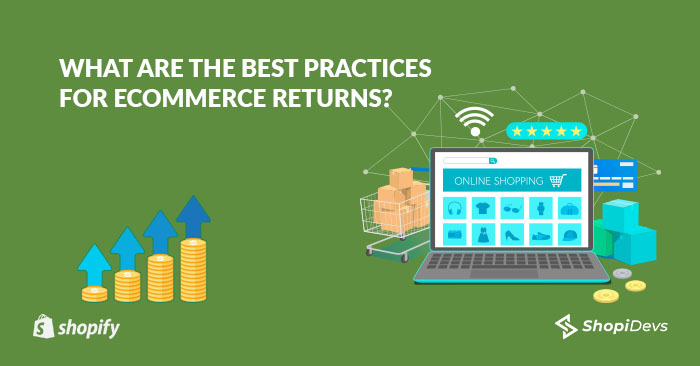Returns are a tiresome issue for all retailers. Especially after Christmas, when a lot is bought but a lot is returned, this is annoying in many ways for any eCommerce business. Because sales are lost, there are costs for the return and, moreover, this also means a relatively large amount of working time for processing the return such as checking the goods, which of course also causes costs. That’s why we will discuss some eCommerce returns best practices in this article.
The fact is, however, that returns are basically the nature of eCommerce. After all, buyers only hold the ordered products in their hands after they have bought them and not, as in brick-and-mortar stores, beforehand, where a product that does not fit can simply be put back.
But returns don’t have to be a nuisance, because on the one hand there is the option of automating them so that less time and effort have to be invested, on the other hand, you can also save costs. And a smooth and uncomplicated eCommerce returns processing ensures satisfied customers, who are then loyal to yours and keep buying something and help to increase business.
Why is an Uncomplicated Return Important for the Customer Experience?
Returns are basically a more abstract form of reviews. Customers are returning items because they don’t seem to have met their expectations. Retailers can, however, ask for the reason that customers usually enter a number in the return form that stands for a reason. For example, if an article is larger. And because only one number is entered, the effort is also minimal. And the certainty that if you have problems with an item you can send it back easily and without any significant effort is particularly relevant for first-time buyers, as they do not yet know the shop. And if everything goes smoothly, first-time buyers may also become regular customers, because the uncomplicated process creates trust. And in the best case, a new order will be placed, for example in a different size.

In this respect, transparency is also very important, so that the return conditions are clearly stated and interested parties know how to return the item if they do not like the purchase. All of this ultimately benefits the conversion rate.
eCommerce Returns as an Opportunity for Retailers
For retailers, on the other hand, the reason for the return is valuable feedback and shows the optimization potential that you may not yet be aware of. Because if certain articles are often sent back for similar reasons, it may be possible to just read them. For example, there is a complaint that an article is larger, a note on the product page helps so that buyers can choose the size accordingly. If the actual color differs from the product image, you could try to make a better picture that shows the actual color. With just a few optimizations, you can reduce the proportion of returns, at least with regard to certain products. Now let’s learn more about the eCommerce returns and also the total idea of conversion rate which may make an impact in the business.
How should Retailers Enable Returns?
An overview:
DOS:
- Return label only if required → return link in the shop
- ideally several shipping service providers
Don’ts:
- A cancellation form must be filled out for the purpose of returning the goods
- The return label must be requested from the support
- Worst case: customers have to take care of everything themselves
In Detail:
Let’s take a closer look at the do’s and don’ts- Adding a return label to the order is not feasible for many shops. While this is convenient for customers, it could also act as a kind of trigger that prompts them to return the item when there is actually little reason to do so.
One possibility would be to send the return label on request by email. However, on the one hand, this involves manual effort for support, which ties up capacities, and on the other hand, customers would be forced to send the parcel back via a specific shipping service provider. And especially for people who do not live in metropolitan areas with parcel shops of different shipping service providers, but in a place with only one parcel shop of a certain shipping service provider, this can sometimes be associated with considerable effort for customers. Not to mention the possible inhibition of contacting support.
For reasons of sustainability too, it makes sense to only create return labels when they are actually needed, as otherwise a lot of waste is created when customers don’t need them because they are satisfied with the order. The worst-case scenario would be that customers first fill out a cancellation form, then send the package back themselves, and thus take care of the process themselves. Because in this way, they are basically left alone, which is also associated with a great deal of effort. And maybe they will take on this effort once – if at all – but then certainly not again.
You May Also Read: Web Accessibility – What Does It Mean In ECommerce?
Conclusion
Returns are part of eCommerce, no matter how annoying they may be. On the one hand, they can help to reveal optimization potential that you as a retailer may not have known about so that the proportion of returns can be reduced with just a few simple readjustments. On the other hand, there are also ways to simplify the process so that retailers do not have to free up unnecessary capacities for the return process. Because uncomplicated and simple processing of eCommerce returns is essential for success, especially when it comes to the conversion rate. Only when interested parties are given the opportunity to simply return the ordered goods if they do not like them or if they have problems, they are more likely to make a purchase so that they ultimately become buyers. And if the entire customer experience is simple and straightforward, they will become loyal regular customers in the best-case scenario.
I’m a digital marketing expert and mobile app developer with a deep understanding of Shopify App Store optimization. I contribute insightful articles on Shopify to help businesses thrive online.



